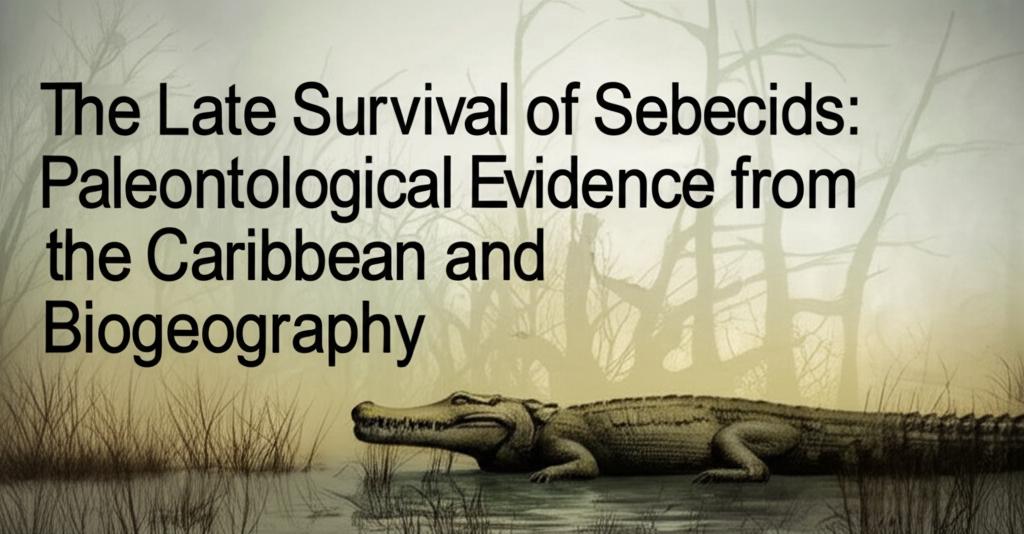Recent paleontological discoveries in the Caribbean have significantly altered our understanding of the late survival of sebecids, a group of terrestrial crocodyliforms primarily known from South America. These findings push back the extinction date of sebecids by at least five million years and paint a new picture of Caribbean ecosystems during the Neogene.
Previously, sebecids were thought to have disappeared from the fossil record around 10 to 11 million years ago, with their remains largely confined to South America and, more limitedly, Europe. However, puzzling discoveries of serrated, blade-like teeth at various Caribbean fossil sites, including Cuba (dating back about 18 million years) and Puerto Rico (around 29 million years old), hinted at a more complex story. While these isolated teeth suggested the presence of a significant predator, they weren't sufficient to definitively identify the animal.
A breakthrough came in early 2023 with the unearthing of not only another sebecid tooth but also two vertebrae in the Dominican Republic. These fossils, dated to be between roughly 4 and 7 million years old (some sources specify as recent as 4.5 million years ago), provided much clearer evidence. The morphology of the vertebrae, particularly their flattened centra, was characteristic of sebecids and distinct from other crocodilians. This discovery confirmed that sebecids, or a closely related form, inhabited the Caribbean and, crucially, persisted there long after their presumed extinction on the South American mainland. This makes the Caribbean population the last known sebecids and, by extension, the last known notosuchians, a broader group of reptiles that first appeared in the Jurassic Period.
Sebecids were formidable apex predators. Unlike their modern crocodilian relatives, they possessed relatively long limbs positioned directly under their bodies, indicating a primarily terrestrial lifestyle. Their skulls were tall and narrow, and their teeth were compressed and serrated, adaptations well-suited for hunting and slicing through the flesh of land-based prey. Some species could reach impressive lengths of up to 20 feet. Isotope analyses of sebecid tooth enamel from older South American fossils suggest they occupied a top position in C3-based food webs in tropical environments. It's probable that Caribbean sebecids played a similar role as apex terrestrial predators for over 22 million years, coexisting with fauna like sloths, rodents, primates, and pelomedusoid turtles.
The presence of these large, land-based predators in the Caribbean challenges previous assumptions about the region's ancient ecosystems. For a long time, it was believed that the Caribbean islands lacked large terrestrial carnivores during the early Miocene. The sebecid fossils indicate that deep-time Caribbean ecosystems were more similar to those in contemporaneous South America than they are today. The eventual extinction of these apex predators in the West Indies during the Plio-Pleistocene likely led to ecological shifts, such as mesopredator release, where smaller predators face less competition and their populations may increase, influencing the evolutionary trajectories of other island species. Modern Caribbean ecosystems lack native terrestrial carnivores of this scale, with niches instead filled by large raptorial birds and the terrestrially adapted Cuban crocodile (Crocodylus rhombifer).
The biogeographical implications of these findings are also significant. How did these primarily terrestrial predators reach the Caribbean islands? The open ocean would have presented a considerable barrier. The timing of their arrival, suggested to be around the Eocene-Oligocene, and their terrestrial adaptations lend support to the "GAARlandia" (Greater Antilles Aves Ridge landia) hypothesis. This theory posits the existence of temporary land bridges or a series of closely spaced islands ("island hopping") that connected South America to the Greater Antilles, facilitating faunal exchange. The sebecid discoveries provide compelling evidence for such a connection. It's hypothesized that a changing, cooling climate over millions of years may have gradually restricted sebecids to tropical latitudes, with the Caribbean islands eventually becoming their final refuge.
The discovery of these late-surviving sebecids underscores the importance of continued paleontological exploration in the Caribbean, a region whose deep-time fossil record is still being uncovered. Many previous discoveries have focused on cave deposits, which tend to preserve more recent fossils. The Dominican Republic sebecid fossils were found by chance during road construction, which exposed older sediments, highlighting the potential for new insights as different types of geological formations are explored. These findings suggest that islands can act as "museums of biodiversity," allowing species to persist long after they have vanished from mainland areas.

